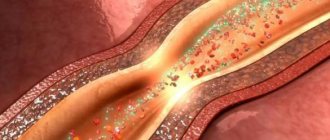general description
Vertebrobasilar insufficiency
is a condition in which there is a decrease in blood supply in the arterial system: basilar and vertebral. As a result of this condition, the nutrition and functions of the brain are disrupted, resulting in irreversible morphological changes in the brain matter.
According to statistical literature, people with vertebrobasilar insufficiency are most often susceptible to strokes in about 25-30% and transient cerebrovascular accidents in 65-70%.
Vertebro-basilar insufficiency: causes, symptoms, treatment
The disease is characterized by repeated attacks of reversible ischemia of brain cells (local decrease in blood supply), as a result of which they do not receive the necessary nutrition.
Ischemic attacks (or small strokes of the vertebrobasilar system) have an increasing etiology of neurological deficit and gradually lead to dysfunction of the central nervous system (CNS).
Most often, vertebrobasilar insufficiency is observed in patients suffering from symptoms of cervical osteochondrosis. The disease can develop in people of different age categories. In the early stages, VBI is completely reversible; in an advanced state, there is a high probability of strokes.
Anatomy
Paired vertebral arteries emerge from the subclavian arteries, located in the upper part of the chest, pass through the openings of the transverse processes of the cervical vertebrae, then through a larger opening into the cranial cavity. At this point, the vertebral beds merge into a single basilar artery, which is based in the lower parts of the brain stem.
The branches extending from the basilar artery wash and supply oxygen and nutrients to the cerebellum, pons, occipital lobes of both hemispheres of the brain, medulla oblongata and other parts. A decrease in blood flow in the vertebral and basilar vessels initially provokes temporary disorders (dizziness, motor dysfunction, loss of coordination of movements and spatial orientation, headaches), a complete cessation of blood circulation provokes necrosis of a certain area of the brain or a stroke.
Causes of the disease
The main reason for the formation of vertebrobasilar insufficiency is a violation of the patency of blood channels (stenosis). Most often, the areas of direct entry into bone canals or the place where arteries merge into one are susceptible to narrowing of the lumen of blood vessels. In addition, the culprits in the development of the disease may be atherosclerotic formations in the vessels, congenital anomalies in the development of the vascular bed, or inflammatory diseases of the vascular system.
The progression of VBI is significantly influenced by growing vertebral bone formations (osteophytes), treatment of spinal spondylosis and/or spondyloarthrosis in older people. The most common causes of deficiency:
- traumatic injuries of the cervical spine;
- thrombosis and thrombophlebitis of blood vessels;
- compression of the vertebral or basilar arteries by displaced vertebrae (spondylolisthesis) or cervical intervertebral hernia, which is not treated;
- damage to small vessels of the brain caused by diabetes mellitus;
- hypertension (high blood pressure);
- fibromuscular dysplasia, spasm of the neck muscles, or vice versa – hypertrophy of the scalene muscle, which impinges on the blood vessels.
Clinical manifestations of VBI
The development of failure is manifested by various neurological symptoms, usually combined, the degree and severity of which depends on the size and location of ischemic foci.
Main manifestations of the disease:
- dizziness, fainting, nausea, vomiting, loss of orientation, balance, are associated with insufficient blood supply to the part of the brain responsible for the vestibular apparatus;
- impairment of the functions of the organs of hearing and vision (tinnitus, flickering of flies or diverging circles, darkening of the eyes, the appearance of rotation of surrounding objects, their bifurcation or blurred contours);
- speech and swallowing disorders (hoarseness, soreness or sensation of a lump in the throat);
- absent-mindedness, memory impairment, poor concentration, fatigue of the body, weakness in the limbs;
- emotional outbursts (sharp changes in mood), autonomic hot flashes (unexpected sweating, feeling of heat in the face or head, rapid heartbeat, surges in blood pressure);
- throbbing, pulling or burning headaches, the treatment of which is difficult, localized in the back of the head.
Diagnosis of the disease
Clinical manifestations of vertebrobasilar insufficiency do not have specific manifestations and may be similar to the symptoms of other diseases. Thus, to establish an accurate diagnosis, a thorough examination of the patient’s complaints, instrumental studies, clinical and laboratory tests is required.
The main method for diagnosing VBI is Doppler ultrasound or duplex scanning of the arteries and vessels of the brain and neck. The methods are based on studying the speed of passage of blood fluid along the bed, are absolutely painless and safe.
Magnetic resonance imaging of the brain allows us to identify foci of previous ischemic attacks, scars, heart attacks, lesions of the brain matter, etc. X-ray images of the cervical spine will show pathological changes in the structures, the presence of hernias, displacements, compressions.
A highly informative method for determining the causes of failure is angiography. Allows you to examine the condition of the walls and lumens of small vessels. Consists of a series of x-rays taken after the patient has been given a contrast dye.
Treatment of vertebrobasilar insufficiency
The initial stages of the disease respond well to treatment on an outpatient basis. In the presence of acute neurological manifestations, persistent stenosis or thrombosis of arterial lines, treatment is recommended in a hospital to prevent the formation of strokes.
The attending physician prescribes complex therapy consisting of medications and physical therapy. At the same time, no general treatment can be distinguished, since each clinical case is considered separately and prescriptions are made individually.
The general advice of specialists can only be to exclude factors that provoke ischemic attacks and affect the condition of the blood vessels of the brain (limiting alcohol consumption and quitting smoking, normalizing body weight, proper rest and nutrition, adequate physical activity, active lifestyle).
Drug therapy usually consists of vasodilators (vasodilators), substances that reduce blood clotting (anticoagulants and antiplatelet agents). To improve blood circulation in the brain and restore affected areas, metabolic and nootropic drugs are used. An indispensable natural remedy in this group are medicines containing extract of the Ginkgo Biloba plant. If necessary, substances are prescribed to control the normal state of blood pressure.
Physiotherapeutic measures consist of:
- general or therapeutic massage (improves blood circulation in pathological areas);
- Exercise therapy (strengthens the muscle corset of the neck, helps relieve spasms, improves the general condition of the body);
- yoga (gently stretches and works deep muscles);
- manual therapy sessions (acupuncture, reflexology, relaxation therapy, plantar massage by Dr. Bobyr);
- wearing a cervical brace (stabilization of the spine in the treatment of spondylolisthesis);
- hirudotherapy or treatment with leeches (effective in treating blood vessels).
Surgical treatment of vertebrobasilar insufficiency is considered only as a last resort and is offered to a fairly small number of patients. The purpose of surgical intervention is to eliminate the lack of blood supply to the brain associated with a decrease in the lumen of blood vessels (stenosis), compression of the arteries by bone structures, intervertebral hernias or spasmed muscles.
Types of operations:
- Vascular angioplasty, in which a special stent is installed in the artery, preventing the lumen from narrowing or blocking the passage opening, allowing the vessels to maintain normal throughput;
- endarectomy - removal of atherosclerotic plaques with part of the internal inflamed wall of the vessel;
- microdiscectomy – removal of part of the intervertebral disc and/or disc herniation with subsequent implantation of stabilization systems or without them.
Author: K.M.N., Academician of the Russian Academy of Medical Sciences M.A. Bobyr
Diagnosis of dizziness due to vertebrobasilar insufficiency (VBI)
Diagnosis for the symptom of dizziness due to vertebrobasilar insufficiency (VBI) includes:
- examination of the patient by a neurologist
- examination of the biomechanics of the cervical spine - muscle tone, range of motion, position of the vertebrae at rest and in motion (radiography with functional tests)
- vascular examination - ultrasound dopplerography, rheovasography (REG), MRI or angiography, etc.
A characteristic moment for the appearance of typical complaints of dizziness and noise in the head and ears against the background of vertebrobasilar insufficiency (VBI) is the age of the patient.
The procedure for Doppler ultrasound (USDG) of the vessels of the neck (carotid artery).
Causes of dizziness due to vertebrobasilar insufficiency (VBI)
The most common cause of dizziness in neurological practice is ischemia (decreased normal blood flow) of the posterior parts of the brain (cerebellum, brain stem, visual cortex of the occipital lobe of the brain) against the background of osteochondrosis of the cervical spine.
This may be accompanied by a natural age-related narrowing of the lumen of the vertebral arteries by an atherosclerotic process (popularly known as “sclerosis”). The vertebral arteries, passing in the transverse processes of the cervical vertebrae, can spasm with the symptom of dizziness against the background of vertebrobasilar insufficiency (VBI).
Osteochondrosis of the cervical spine can lead to reflex spasm of the vessels of the cervical spine - these are the vertebral artery and the carotid artery. As a result of this spasm, disturbances in the blood supply to the brain structures occur with attacks of dizziness, noise and ringing in the ears and head, unsteadiness when walking, numbness of the face and tongue, etc.
Other factors that cause dizziness due to vertebrobasilar insufficiency (VBI):
- cervical spine injuries
- syringomyelia
- atherosclerotic lesions of the vertebral arteries and basilar artery of the brain
- intoxication (during pregnancy)
- multiple sclerosis
- Meniere's syndrome
- acoustic neuroma
- spasm of the sternocleidomastoid muscle, etc.
Nausea and vomiting can occur with both types of nystagmus (central and peripheral). These symptoms are more pronounced during an attack of peripheral dizziness. In response to provocative tests carried out by a doctor (Baranyi, Dix-Hall), peripheral type dizziness occurs in the patient with a delay (after 2-5 seconds), while for central type dizziness it occurs without or with a short time delay.
Peripheral type dizziness is more dependent on body position than central type dizziness. Peripheral type vertigo is usually associated with horizontal or rotatory nystagmus, while central type vertigo is more often associated with horizontal, vertical or rotatory nystagmus. Small-scale nystagmus in its origin is associated with lesions of the cervico-occipital joint or cerebellum.
With a decrease in blood flow in the vertebral system and the basilar artery, the work of the cerebellum suffers, and a symptom of dizziness occurs against the background of vertebrobasilar insufficiency (VBI).









